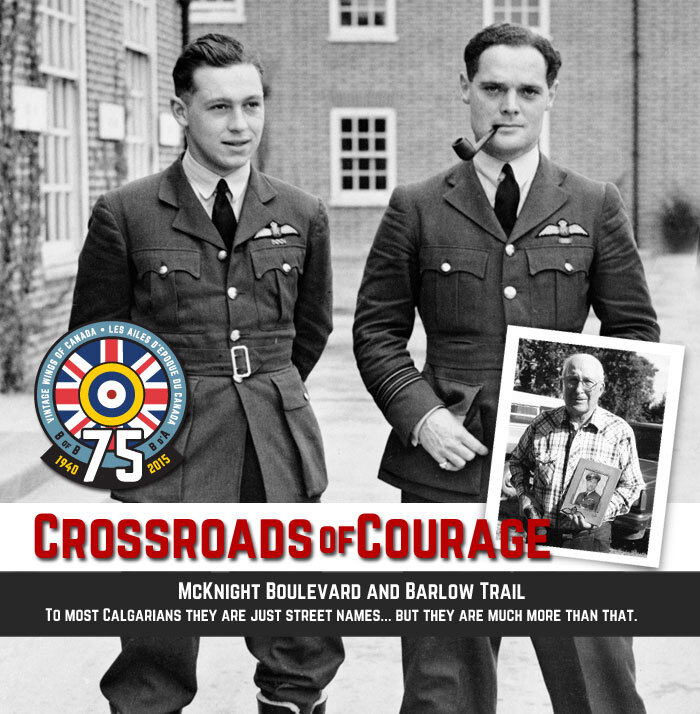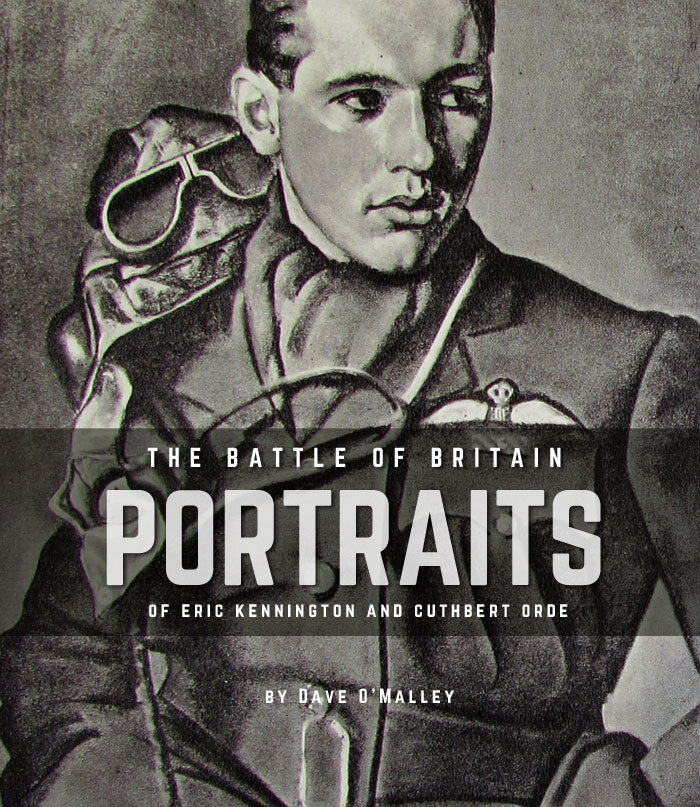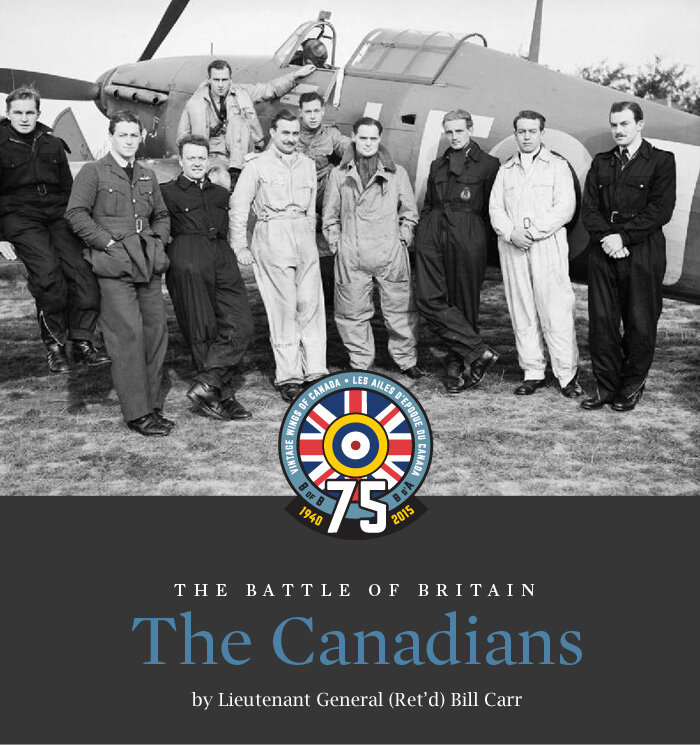GETTING IT RIGHT — A Sneak Peek
Just a few days ago, the fuselage of the Vintage Wings of Canada Hurricane Mk XII was pulled from the paint booth wearing her brand-new markings—those once carried by a Hurricane Mk I flown by Canadian Battle of Britain ace Flying Officer William Lidstone McKnight. On this the 95th birthday of the Royal Canadian Air Force, we thought we would share with you our pride in both McKnight and the meticulous work that went into researching and applying this historic set of markings.
Aside from very poor photographic evidence from 1940 of McKnight’s now-famous Grim Reaper artwork on the side of his aircraft, very little is 100% provable about the other markings on the aircraft—the roundels, the fin flashes, serials, squadron codes and other standard elements that enable one to tell the difference between one Hurricane and another.
In the period immediately following Great Britain’s declaration of war on Nazi Germany, the markings applied to Royal Air Force aircraft in the factories and on operational squadrons were in a state of transition and confusion. Air ministry directives and factory interpretations of these directives, new RAF standard paints and their availability, component repairs carried out by Civil Repair Organization contractors, operational repair and repaint at squadron and maintenance unit levels and the exigencies of combat operations all combined to make many aircraft paint schemes unique. In a single squadron of Hurricanes, there could be several sizes of roundels, two or three different types of fin flashes and a number of different underside paint treatments—all depending on airframe squadron attrition, maintenance and repair schedules, recent deployments and changes in Air Ministry paint policy and factory interpretation of these standards.
One thing we do know is that McKnight’s Hurricane I was RAF Serial No. P2961 and that it was one of the 2,750 built by Gloster Aircraft Company. After months of relentless photo research we found a number of photos of Gloster-built Hurricanes with serial numbers that indicated they were from the same batch. Then we came across three photos of P2959, a Hurricane that was just two airframes ahead of P2961 in the factory at Hucclecote, Gloucestershire. The type and size of roundel, serials and fin flash are abundantly clear in these photos—enough to take measurements. This airframe could easily have come off the line just a few hours before P2961 and we feel that the manner in which it is painted is very likely the way McKnight’s P2961 was painted. We’ll never know for sure, since it is entirely possible that the factory standards for these identifying marks may have changed for airframe P2960 or P2961. Not likely… but possible.
The next step is to begin painting the wings, empennage and undercart. Regardless, we thought you would like to see the result of our hard work to get the markings right. Enjoy.
Pilot Officer William “Willie” McKnight, left poses at Duxford in 1940 with his 242 Squadron commander Squadron Leader Douglas Bader (centre) and Flight Lieutenant Eric Ball. Photo: Imperial War Museum
The handsome Flying Officer William Lidstone McKnight, DFC, a Canadian fighter pilot in the Royal Air Force, was that country's leading ace during the Battle of Britain. McKnight survived the Battles of France and Britain, only to die in combat in January of 1941, when his Hurricane failed to return from a sortie over the English Channel. Photo: Imperial War Museum
Related Stories
Click on image
Once the fuselage is complete, we will be hand painting McKnight's famous artwork depicting a skeletal Grim Reaper with a sickle pointing towards the enemy as well as, on the lower engine cowling, the image of Hitler being kicked in the arse with a black leather 242 Squadron flying boot.
McKnight leans confidently against the starboard wing of LE-A. This extremely poor photograph, along with the previous one, are the only two photographs known to exist of McKnight's Gloster-built Hawker Hurricane P2961. Every other detail concerning P2961's paint scheme — fin flash, roundel sizes, stencilling and serials — remains today only conjecture. After months of research by us at Vintech Aero and the much-appreciated assistance of Canadian aviation historian and artist Terry Higgins of Aviaeology and others, we have managed to get closer to what we believe McKnight's Hurricane looked like.
This and the following photographs, which came to light towards the end of our search, have solidly informed our final decisions regarding how LE-A might have actually looked. It depicts Gloster-Built Hawker Hurricane P2959 being inspected by a German airman in an airfield junkyard at Nantes, France. P2959, just two airframes ahead of P2961 on the Gloster assembly line is probably the closest we will ever get to a definitive answer as to how P2961 was painted. There seems to us a high probability (though not 100%) that there were no changes in the standardized paint scheme employed by Gloster at the time between the two airframes. Photo via RAFCommands.com
Another look at P2959. From these photos we made the decision to use a similar 35-inch Type-A roundel in the standard position with 7 inch bands but with an outer yellow band of just 5 inches. As well, the fin flash extends from the horizontal stabilizer to the upper rudder break. P2959 was to be delivered to 501 Squadron at nearby Le Mans. It appears that the aircraft did not survive long enough to get 501 Squadron codes applied. Perhaps it was seriously damaged on delivery as it does not appear to have damage caused by combat. To make it useless to the Lufwaffe, the retreating RAF have removed its wings outboard of the box spar (possibly taking them back to England) and have lopped off its propeller blades and empennage. In the background sit two forlorn Fairey Battles, part of the ill-fated combat debut of that poor-performing light bomber. Photo via TD
Positions of Sky Band (left) and Squadron/Aircraft codes and stencils were first roughed in with tape to get best alignment and sizes. Photo: Dave O'Malley
Once we sized the squadron codes (30 inches) and roundels (35-inch Type-A with outer yellow ring of 5 inches), we carefully positioned the letters and discussed the final details. The cost of a top paint job is such that there was much discussion and measuring before we committed. Photo: Dave O'Malley
The port side of the McKnight Hurricane showing the 18-inch fuselage band painted in “Sky” colour (the spinner is also to be painted in “Sky”). These two paint scheme additions were mandated by the Royal Air Force and were painted on P2961 in November of 1940 following the Battle of Britain. There are plenty of photographs in the web of Hawker Hurricanes from the period with these later addition “Sky Bands” painted on over the aircraft's serial number. But there are also plenty of examples where the serial number is either repainted over these Sky Bands or the Sky paint is carefully painted around the serials. We couldn't find an example of a 242 Squadron Hurricane Mk 1 with these bands, but we painted the RAF serial over the Sky Band for two compelling reasons—there is a photograph of 242 Squadron Hurricane IIs with the serials in painted black over the band (quite possibly painted this way at the factory) and at the time of P2961's operational history, 242 Squadron always used the aircraft serials when reporting unit activity and sorties in their Operations Record Books. We felt that the serials were of some importance to the squadron adjutant who was tasked with filling out the ORBs and squadron diaries and therefore were likely to not be painted over. Photo: Pat Tenger
The underside of Hurricane P2961 changed three times in its 7-month operational history. It came from the Gloster Factory painted in the standard of the day—“White/Night”. The aircraft was split down the centreline with white on the starboard half and a black colour called “Night” on the port side. The “White/Night” scheme was designed to enable easy identification between friend or foe by England-based anti-aircraft gunners, but on June 6, 1940, operational squadrons (in England and on the continent) were ordered to paint the entire undersides of their fighters in “Sky”. However, Sky was a recently-introduced standard colour and had only been issued to factories and post-factory maintenance units and had not yet made its way down to operational squadrons. Another order ensued the very next day directing squadrons instead to paint the underside a “Duck-egg Bluish Green” — not an official colour and something that was open to interpretation. The following day (June 8), 242 Squadron was ordered to France along with its aircraft. That left just a few days for the unit to ready their aircraft and get them painted. We believe that, if they had followed this order to the letter, the aircraft underside could not be “Sky”, but possibly one of two “similar” paint colours available to them (“Sky Blue” or “Eau-de-nil”) OR a custom mixed colour that approximated “Duck-egg Bluish Green”. As “Eau-de-nil” is a rather ugly colour and “Sky Blue” was very susceptible to interpretation, we opted for the latter option — a hand mixed shade of “Duck-egg Bluish Green”. The colour itself is very similar to that depicted by Aviaeology, the acknowledged experts on the markings of LE-A, in their documentation for a set of 242 Squadron Hurricane I decals. Photo: Pat Tenger
Another view of the underside of LE-A showing the non-standard “Duck-egg Bluish Green”—a colour which is just slightly different from the “Sky” band which was painted around the rear of the fuselage as ordered by the Air Ministry in November of 1940. By this time, “Sky” was readily available to squadron riggers and was almost definitely used (the previously black propeller spinner was also repainted “Sky” at the same time). At this time, all squadrons were also ordered to paint the underside of the port wing in “Night”— not like the original split down the centreline, but just the wing from the centreline outwards. Photo: Pat Tenger
Another view of the port side with RAF roundel and RAF fin flash. Photo: Korrey Foisey
There are many ways in which the classic RAF “fin flash” could be applied (Three alternates shown in lower image). We chose to stick to the fin flash worn by P2959, making the assumption that not much changed between the two aircraft on the assembly line—in this case three vertical 10-inch bars ending at the rudder break. Top Photo: Pat Tenger




















